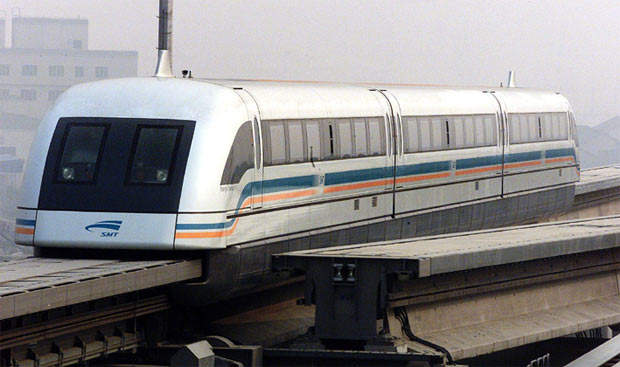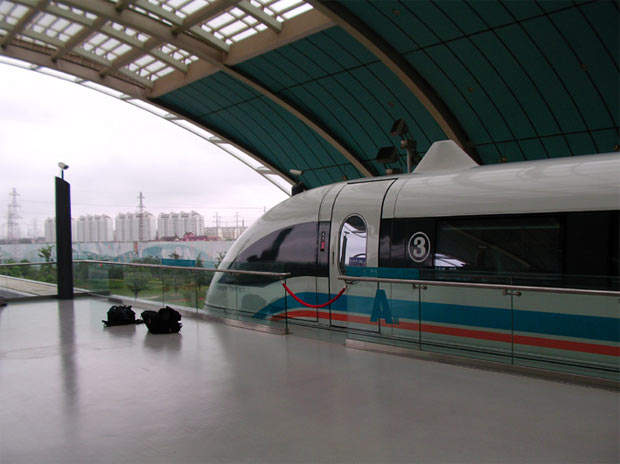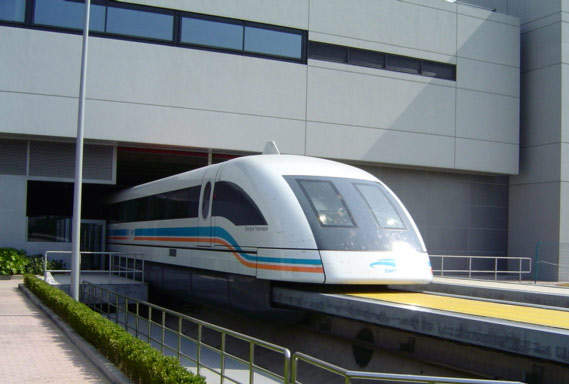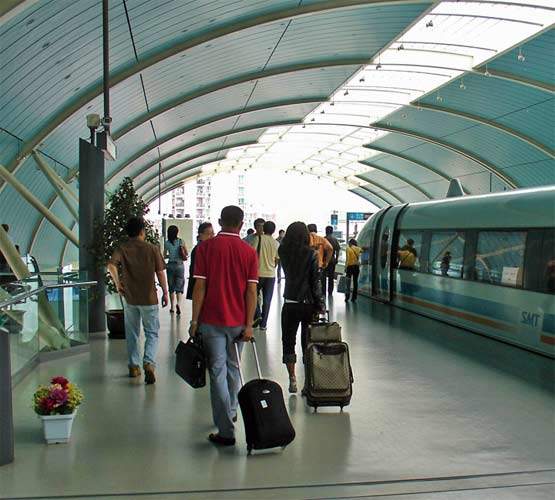Far from dawdling with technology, China is making rapid moves to improve railway transport within the country. It has embarked on two ambitious high-speed railway lines using conventional steel wheels and rails.
In its quest to provide even faster ground transportation, China announced approval to build the world’s first long distance commercial magnetic levitation railway (Maglev) in March 2006. The concept uses magnets to move the train at speeds of up to 430km/h (270mph), and would be the first time anywhere in the world that this type of technology has been used over any great distance.
China is currently home to the 30km (19 mile) maglev line using the German Transrapid system from Shanghai Pudong International Airport to Longyang Road for transfer to Metro Line 2, completing the journey in eight minutes. With technology transfer from Germany, China originally planned to put the new maglev line from Shanghai to Hangzhou into service by 2010, in time for Shanghai’s hosting of the May-October Expo World Fair.
THE PROJECT
The proposed maglev line will stretch for 175km (109 miles) from Shanghai southwest to Hangzhou, the capital of Zhejiang province.
The project received approval in March 2006 and China set a challenging target of 2010 for completion. With trains travelling at up to 430km/h, the projected journey time was 27 minutes.
The new route will, as with the Pudong Airport line, be based on German maglev technology. An agreement for technology transfer between China and Germany was reached in early 2006.
INFRASTRUCTURE
There are currently three types of magnetic levitation railway available to China – its own version, which has been tested in Dalian, German technology from Transrapid and Japanese systems.
The German Transrapid comes from a consortium of Siemens, ThyssenKrupp and the German government. Initially, this was seen as the way forward for the project. The Shanghai Pudong airport line uses the German technology and has generally performed well, although an on-board fire occurred in 2006. Falling below expected levels of patronage, the service has received criticism for the fare levels and because most passengers still have to transfer to other modes for journeys involving central Shanghai.
The system using normal-conducting electromagnetic levitation to provide propulsion compares favourably in cost terms with the more expensive Japanese technology using superconductor materials. However, the new line was expected to cost in the region of ¥335bn ($4.5bn).
Maglev trains float on magnetic cushions, allowing them to reach much higher speeds compared to conventional high speed lines, which can only reach a maximum of 300km/h (186mph). Trains can reach 430km/h, and as such is held by its supporters as an effective way to transport large numbers of people at very high speeds, and with clean energy.
Previous maglev railways have mainly used elevated trackbeds built from concrete, and this style of construction is expected for the Hangzhou route. Very high speeds are possible due to the minimal friction encountered between the train and the track. The main source of friction is passing air, as the train has virtually no physical contact with a surface.
ROLLING STOCK
The line will require new trains, but few companies build such units as they have to be tailored to the trackbed, and also the lack of continuity of orders precludes the existence of a production line to reduce unit costs. The trains have no wheels, axles or pantographs and use non-contact electromagnetic levitation to guide the train along a trackbed. An additional feature of maglev is that the trains emit little noise, and energy consumption is low.
Transrapid maglev vehicles comprise a minimum of two sections with around 90 seats per car, but the formation can be increased up to ten sections in length without any reduction in acceleration. The trains can also be adapted for the movement of low-weight goods, up to 15t per section.
SIGNALLING AND COMMUNICATIONS
A central control and operations centre will be built as part of the Shanghai-Hangzhou project. The operations room has full control of the position of turnouts and all other safety features. The location of each train can be monitored at all times using onboard system.
As an additional safety feature, the propulsion system in the guideway allows collisions with other vehicles to be ruled out, although the serious accident in 2006 (the first fatalities involving a maglev vehicle) at Transrapid test track in Emsland, Germany, demonstrated that hazards apart from other trains were equally relevant.
THE FUTURE
By mid-2007, the future of the project had become unclear. Official sources indicated that public opposition related to noise and radiation fears, heightened by the narrowness of the zone to be left between housing and the track, had caused a suspension of the project pending further studies to be carried out by the State Environmental Protection Administration. With added opposition fuelled by claims that the project costs, and thus use of public funds, were continuing to escalate, protests in 2008 led to police intervention.
A report in early 2008 declared the line would not cause harm and it was elsewhere stated that the Expo 2010 target could still be attained.
In spite of this, there remains uncertainty as project costs look less attractive than a high-speed rail alternative for Shanghai-Hangzhou. This would offer greater flexibility of operation, compatibility with other lines and an end-to-end timing of only around ten minutes more than the maglev service.
The maglev mode received a short-lived boost in 2007 with announcement of a 37km Transrapid line to be built between München Hauptbahnhof in the city centre and the international airport. This was to be jointly funded by Transrapid, Deutsche Bahn and the governments of Bayern and Germany.
However, the cancellation of that project in March 2008 due to a doubling of costs seems likely to have further damaged the fragile case of the maglev format. Despite this, confidence remains high on the part of Japanese operator JR Central who is continuing with the development of the ambitious Chuo Shinkansen maglev between Tokyo and Osaka, the first part of which, Tokyo to Nagoya, could begin services by 2025.
Whether the Chuo Shinkansen, Shanghai-Hangzhou or any project becomes a proving ground for the maglev concept over long distances remains far from certain.







